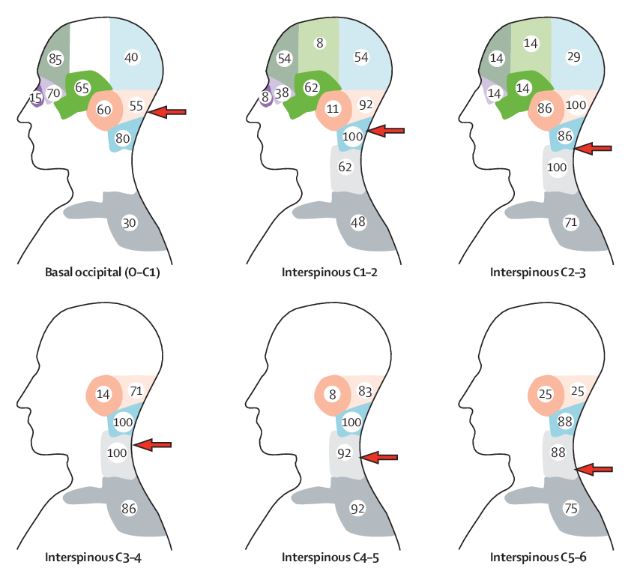This type of headache is caused by disorders of the cervical spine and is also a very common headache (20-30%). These include cervical disc herniation, degeneration of cervical facet joints, tension in neck muscles, and irritation of upper cervical nerves. Typically, the pain originates from the back of the neck and radiates to the top of the head and behind the eyes. It can be unilateral and may spread from one side to the other. Pain from the cervical facet joints radiates to the neck, head, and scalp. 1
A typical patient is someone who has suffered an injury from an accident or whiplash (Whiplash Associated Disorder (WAD)) (car accident, snowboarding, cycling accident, etc.), and another large group includes those who struggle with chronic postural abnormalities (e.g., dentists, computer users), but it also includes those who are genetically predisposed to weak connective tissue.
To clarify the diagnosis, the patient’s medical history, physical examination, and diagnostic imaging tests are necessary (Cervical MRI, flexion-extension X-ray, DMX (Digital Motion X-ray)).
Treatment
Their treatment is multi-faceted, including lifestyle changes, posture improvement, physical therapy, manual therapy, and minimally invasive approaches such as stem cell or PRP treatment for facet joints and discs, which can regenerate neck ligaments, improve neck mechanics, and potentially prevent or slow down degenerative processes.
The PICL (Percutaneous Implant of Craniocervical Ligaments) procedure offers the possibility of regenerative treatment for the transition between the neck and head. During the procedure, stem cells or PRP are injected under X-ray guidance into the atlantoaxial (middle and lateral) and atlantoccipital joints and their associated ligaments.
Usually, the lower part of the cervical spine is also treated.
Another treatment option is cervical medial branch radiofrequency ablation. During this procedure, the innervation of the cervical facet joints is interrupted, reducing the sensation of pain.2

This procedure is always preceded by a diagnostic injection.
Source:
1. Bogduk N, Govind J. Cervicogenic headache: an assessment of the evidence on clinical diagnosis, invasive tests, and treatment. Lancet Neurol [Internet]. 2009;8(10):959–68.
2. Manchikanti L. Facet joint pain and the role of neural blockade in its management. Curr Rev Pain. 1999;3(5):348–58.


